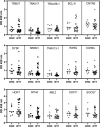Absence of specific autoantibodies in patients with narcolepsy type 1 as indicated by an unbiased random peptide-displayed phage screening
- PMID: 38442093
- PMCID: PMC10914298
- DOI: 10.1371/journal.pone.0297625
Absence of specific autoantibodies in patients with narcolepsy type 1 as indicated by an unbiased random peptide-displayed phage screening
Abstract
Narcolepsy type 1 (NT1) is an enigmatic sleep disorder characterized by the selective loss of neurons producing orexin (also named hypocretin) in the lateral hypothalamus. Although NT1 is believed to be an autoimmune disease, the orexinergic neuron-specific antigens targeted by the pathogenic immune response remain elusive. In this study, we evaluated the differential binding capacity of various peptides to serum immunoglobin G from patients with NT1 and other hypersomnolence complaints (OHCs). These peptides were selected using an unbiased phage display technology or based on their significant presence in the serum of NT1 patients as identified from previous studies. Although the subtractive biopanning strategy successfully enriched phage clones with high reactivity against NT1 serum IgG, the 101 randomly selected individual phage clones could not differentiate the sera from NT1 and OHC. Compared to the OHC control group, serum from several NT1 patients exhibited increased reactivity to the 12-mer peptides derived from TRBV7, BCL-6, NRXN1, RXRG, HCRT, and RTN4 proteins, although not statistically significant. Collectively, employing both unbiased and targeted methodologies, we were unable to detect the presence of specific autoantibodies in our NT1 patient cohort. This further supports the hypothesis that the autoimmune response in NT1 patients likely stems primarily from T cell-mediated immunity rather than humoral immunity.
Copyright: © 2024 Tran et al. This is an open access article distributed under the terms of the Creative Commons Attribution License, which permits unrestricted use, distribution, and reproduction in any medium, provided the original author and source are credited.
Conflict of interest statement
The authors have declared that no competing interests exist
Figures





Similar articles
-
Narcolepsy Type I as an autoimmune disorder.Handb Clin Neurol. 2021;181:161-172. doi: 10.1016/B978-0-12-820683-6.00012-9. Handb Clin Neurol. 2021. PMID: 34238455 Review.
-
Prostaglandin D2 Receptor DP1 Antibodies Predict Vaccine-induced and Spontaneous Narcolepsy Type 1: Large-scale Study of Antibody Profiling.EBioMedicine. 2018 Mar;29:47-59. doi: 10.1016/j.ebiom.2018.01.043. Epub 2018 Feb 2. EBioMedicine. 2018. PMID: 29449194 Free PMC article.
-
Autoantibodies in Pandemrix®-induced narcolepsy: Nine candidate autoantigens fail the conformational autoantibody test.Autoimmunity. 2019 Jun;52(4):185-191. doi: 10.1080/08916934.2019.1643843. Epub 2019 Jul 22. Autoimmunity. 2019. PMID: 31328572
-
Screening for autoantibody targets in post-vaccination narcolepsy using proteome arrays.Scand J Immunol. 2020 Apr;91(4):e12864. doi: 10.1111/sji.12864. Epub 2020 Feb 13. Scand J Immunol. 2020. PMID: 32056243
-
Management of Narcolepsy.Curr Treat Options Neurol. 2016 Oct;18(10):43. doi: 10.1007/s11940-016-0429-y. Curr Treat Options Neurol. 2016. PMID: 27549768 Review.
References
MeSH terms
Substances
LinkOut - more resources
Full Text Sources
Medical
Molecular Biology Databases
Miscellaneous

